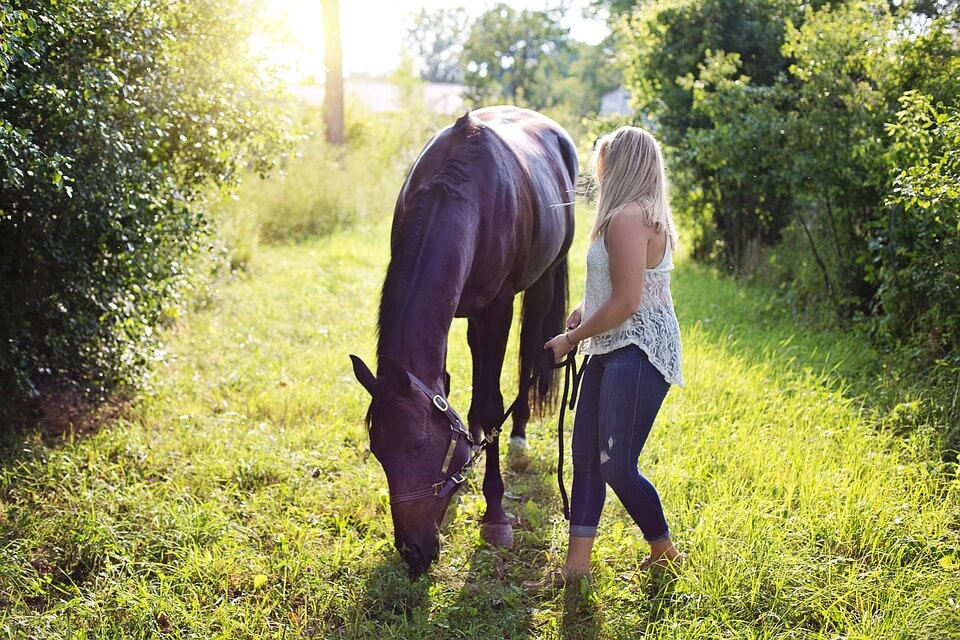What are gastric ulcers for the horses ?
The development of horses is a complex subject, as they can be affected by many pathologies throughout their lives. In particular, many health problems are related to the digestion of horses. Many horses can suffer from ulcers, whatever their discipline (breeding horses, sport horses, endurance, racing, or simply retired). There are 2 types of ulcers:
- Ulcers located on the non-glandular, so-called “squamous” part of the stomach. This type of ulcer is called ESGD (Equine Squamous Gastric Desease) in scientific publications.
- Ulcers located on the glandular part, their appearance is rather linked to repeated stress situations and/or the intensity of the work required. This is called EGGD (Equine Glandular Gastric Desease).
Several aggravating factors have been highlighted in the appearance of ulcers, which are directly related to the management of the horses’ diet, but also to the composition of the daily feed.
- The first factor is the absence of forage: if horses are fed only concentrates, at best three per day, this leaves room for long periods of “empty stomach”. Note that the horse in its “natural” state is used to ingesting small amounts of forage for about 16 hours a day, which leaves room for only very short periods of empty stomach. Also, the lower part of the stomach has a rather acidic pH (between 2 and 4), which means that when this part of the stomach is empty, the acidity attacks the lining and causes pain because acid secretion is continuous in the horse, even when there is no food in the stomach. Chewing causes the production of saliva, which normally counteracts this acidity by having a real buffering effect on the stomach contents, so if the horse does not receive a feed ration, it cannot produce saliva.
- The second aggravating factor for this type of ulcer is the starch content of the horse’s diet, in other words, its composition of cereals. In fact, the more cereals the feed contains, the higher the starch concentration. It should be borne in mind that the horse is a herbivore, so cereals are not normally part of its diet in their natural state. Cereals are not sufficiently supplied with amylase, which are responsible for the proper digestion of starch. The consequence of an excess of starch in the diet is also a decrease of the pH (acidity) through the production of lactic acid, which creates a favorable environment for the appearance of ulcers on the “non-glandular” (“unprotected”) walls of the stomach.
- In particular, sport horses are often subjected to intense training, which requires a rich diet to meet all their energy needs. Studies indicate that 55 to 60% of sport horses suffer from gastric ulcers. A balanced diet is therefore the key to combining the horse’s well-being and sporting performance. However, many feeds for sport horses contain cereals (because they are very good sources of energy) and therefore starch, which can lead to the appearance of ESGD-type ulcers, and therefore cause great inconvenience to these horses. It is therefore important to measure the starch intake in their ration. This intake is measured in grams per meal, not in daily quantity. This can allow us to increase the number of meals per day and if necessary increase the starch content of the daily energy intake.
How to recognize the symptoms of ulcers for sport horses ?
There are many clinical signs that may indicate the presence of gastric ulcers in your sport horse. In particular, if your horse’s appetite becomes capricious (if he does not eat his ration, sorts his food, eats slowly…), if you notice a loss of general condition, a decrease in performance not explained by other physical factors, a change in behavior (more aggressive, or lack of enthusiasm), colic of low intensity especially after meals, pain at the time of girth, yawning just before or during the ingestion of food… However, the absence of symptoms does not mean that your horse does not suffer from ulcers, some horses do not show any external signs of pain.
How to prevent the appearance of ulcers ?
With regard to the possible care of ulcers, recommendations regarding the two aggravating factors mentioned above have been put forward, following the publication of scientific trial results:
- Firstly, horse feed: the horse should receive a minimum amount of feed of 1.5kg per 100kg live weight (so for example about 7.5-8 kilos of feed per day for a 500kg horse, to be divided into at least two meals)
- Limit the amount of starch in the horse’s diet by substituting carbohydrate energy (starch) with fat energy (fats)
- Do not work the horse immediately after a meal of concentrates (if possible, work the horse after a meal of assimilated hay), and do not give him concentrated feed immediately after work.
- Salivation: a solution that has also proved its worth is to increase the horse’s salivation in order to counteract the acidity of the stomach. This can be done by feeding long-brown fiber concentrates such as alfalfa brown.
- Encourage the intake of pre-biotics (live yeast) and essential fatty acids (omega 3 and omega 6)
In the most serious cases, the veterinarian can prescribe treatments. A gastroscopy can help the veterinarian to establish his diagnosis and a posteriori to verify the effectiveness of the treatments.
In terms of ulcer prevention, it is important to pay attention to your horse’s living conditions. The way your horse lives (stall or pasture) can have a great influence on the appearance of EGGD ulcers. In particular, confinement can cause a very stressful situation for a horse. It is therefore necessary to adapt the horse’s lifestyle so that it can feel more fulfilled.
How to feed your sport horses ?
As the nutrition of the horses can play a preventive role for the ulcers of the non-glandular mucous membrane, Royal Horse has reasoned the contribution of starch in all the formulas of food, that allows us not to reach the critical limit of the contributions in starch (saturation of the role of the amylases and production of lactic acid in the stomach) calculated for a distribution in three meals per day. A provision which ensures, in addition to the systematic presence of prebiotics (M.O.S) in our formulas, a gastric comfort to your horses.
In addition to all these provisions Royal Horse has in its offer a specific food solution for the horses suffering from ulcers which is whose formula is the fruit of numerous researches and recommendation on the subject: this food concentrates all the recommendation which we have just enumerated you:
- Mixed composition with pellets and long alfalfa browns
- Starch content limited to 10%.
- Energy provided by a high content of vegetable fat with a ratio omega 6 / omega 3 optimal for their use
- GWB (Gastric Wall Bulder), an active ingredient based on plant extracts to support gastric comfort.
This horse feed is available as a ready-to-use mixture of pellets specifically formulated to combat this type of problem and long brown alfalfa (H150).




